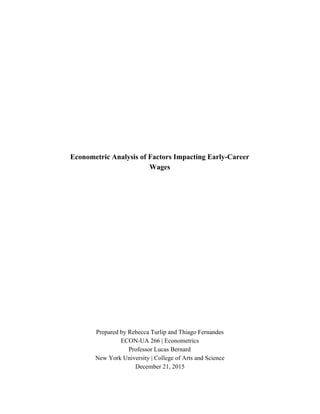
StartingSalaryAnalysis
- 4. Turlip & Fernandes 3 The data obtained through the aforementioned sources was analysed in STATA using regression and correlation analyses. In addition, tests like the White test, imtest, and hettest were used to check for heteroskedasticity, skewness, and kurtosis. The above combination of tests ensured that the regression model was a good fit with the data by making sure the predicted estimations matched closely with the actual results. Below is the standard regression model, including an overview of the variables used in the analysis: tarting Salary x β (popDensity) β (tuition) β (undergradEnroll) β (pctMale)S = 0 + 1 + 2 + 3 + 4 β (avgSAT) β (pctSTEM) + 5 + 6 Variables and their expected signs: Starting Salary (Dependent): Starting salary denotes the amount of income that college graduates have earned from entry level jobs (05 years work experience). Usually, when measuring earnings, the natural log is used. However, with this data set there were no major outliers for median starting salaries that might have affected our results, i.e. if one of the median salaries were $100,000 or more. Starting salary was used as the dependent variable in order to see the different factors that went into influencing its size. Population Density: This independent variable, the population density of the municipality of each university in our list, was used in lieu of a proximity measure to the closest metropolitan area. Population density is a good representation of access to opportunities and resources for undergraduate students and employers alike. We hypothesized that in larger cities where there is greater population density, the starting salaries will be higher, therefore resulting in a positive correlation between the two variables.
- 7. Turlip & Fernandes 6 Results ANOVA Analysis Table 1: results from simple regression tarting Salary 9820.056 0.09713(popDensity) 0.10695(tuition) 0.06081(undergradEnroll))S = + + + 119.4086(pctMale) 20.9181(avgSAT) 171.2699(pctSTEM) + + + R² value, pvalue, and coefficients Rsquared, also known as the coefficient of multiple correlation, is the proportion of total variation of Starting Salary explained by the regression of Starting Salary on tuition, undergradEnroll and all of the other independent variables. Tab1e 1 reads an Rsquared value of 0.8142. An Rsquared value so close to one indicates how well the regression equation fits the data. Another important factor in the above table is the consistent low pvalues. All pvalues being below our significance level of .05, we were able to reject the null hypothesis. Ensuring an Rsquared value close to one and pvalues close to zero was crucial for our empirical model to be